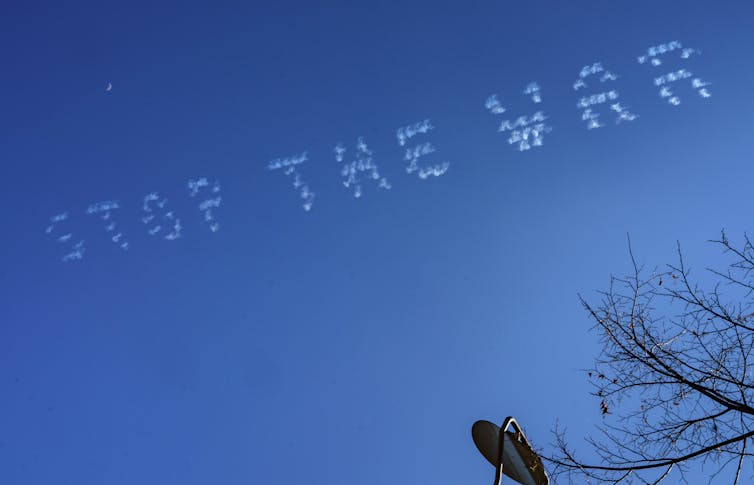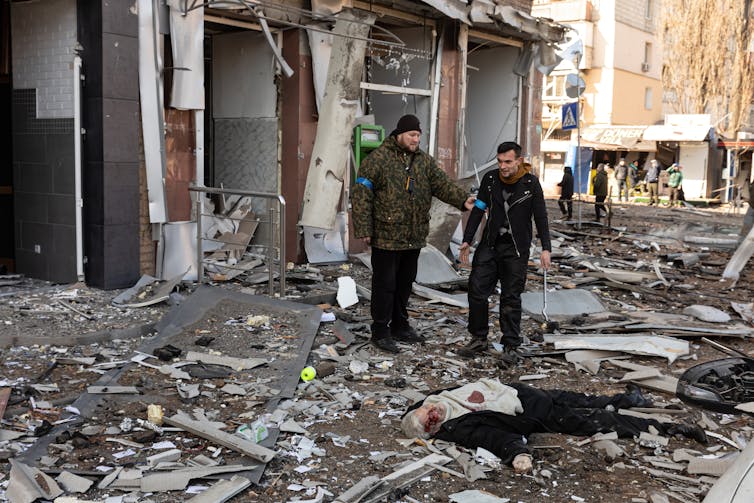Ukraine wants a no-fly zone. What does this mean?
Ukraine wants a no-fly zone. What does this mean, and would one make any sense in this war?

Christopher Michael Faulkner, US Naval War College and Andrew Stigler, US Naval War College
Ukrainian President Volodymyr Zelenskyy virtually addressed the United States Congress on March 16, 2022, and, as widely expected, requested additional U.S. military assistance for Ukraine.
Zelenskyy also asked for the U.S. to create a no-fly zone over some portion, or potentially all, of Ukraine.
“Russia has turned the Ukrainian sky into a source of death for thousands of people. Russian troops have already fired nearly 1,000 missiles at Ukraine, countless bombs. They use drones to kill us with precision. This is a terror Europe has not seen for 80 years,” said Zelenskyy, delivering the first virtual address by a foreign leader to Congress. He wore the army green T-shirt that has become his civilian uniform while leading Ukraine’s response to the war from Kyiv.
“Is this a lot to ask, to create a no fly zone over Ukraine to save people? Is this too much to ask? A humanitarian non-fly zone, so that Russia would not be able to terrorize our free cities,” Zelenskyy continued.
Zelenskyy paused during his address to play a video documenting the war in Ukraine. That video ended with the words, “close the skies over Ukraine.”
This is not Zelenskyy’s first request for U.S. intervention in Ukrainian skies. Zelenskyy spoke with more than 300 members of Congress on March 5, 2022, urging them at that point to “close the skies or give us planes.”
Since Russia first invaded Ukraine on Feb. 24, 2022, the Biden administration has consistently said that a no-fly zone is not a viable option. This is necessary to avoid unnecessary escalation of the situation, they claim.
A growing number of U.S. foreign policy experts have publicly asked the Biden administration and NATO allies to protect Ukraine with a limited no-fly zone.
And recent polling has found that a clear majority of Americans support a no-fly zone.
As national security scholars, we think it is important to understand what a no-fly zone entails and what the consequences might be if the U.S. or any other NATO ally sets one up.

Protecting civilians and enforcing the zone
No-fly zones are often used to protect civilians on the ground from warplane attacks and to prevent a country from gaining air superiority, meaning control of the sky over a battlefield. Both are important considerations in Ukraine.
Designating an area a no-fly zone bans certain aircraft from flying over an established area.
To be effective, no-fly zones require a credible threat of a military action if a target country violates banned airspace and sends aircraft into this area.
In other words, a country that declares a no-fly zone must then be ready to enforce the protected space. Enforcement can include a host of options, including firing at aircraft that have breached the zone.
This could also include having the enforcing country destroy grounded planes or helicopters, and attacking runways to limit the targets’ ability to take off or land aircraft.
Historical examples of no-fly zones
No-fly zones are a relatively new phenomenon that emerged after the Cold War. Since the early 1990s, the U.S. and allies have declared four bans of this kind. There have been many other instances in which the U.S. considered, but never implemented, no-fly zones.
The U.S., United Kingdom and France first implemented two no-fly zones against Iraq following the first Gulf War. These bans lasted from 1991 to 2003. Operation Provide Comfort, in northern Iraq, later renamed Operation Northern Watch, sought to protect Kurdish communities in that region of Iraq from attacks carried out by Saddam Hussein’s regime.
Operation Southern Watch, established slightly later and in the country’s south, was designed, in part, to provide protection to the Shia population in southern Iraq.
Other instances of no-fly zones include Operation Deny Flight, a NATO-led effort to protect civilians from attacks during the Bosnian war from 1993 to 1995.
The U.N. Security Council also backed a no-fly zone in Libya during the country’s 2011 civil war. A NATO-led military coalition intervened in Libya to enforce this U.N. resolution.
No-fly zones have never stopped a war. In Bosnia in the 1990s, NATO-led no-fly zones may have reduced the Serbs’ opportunities to attack Bosnian Muslims and others. But it is extremely hard to determine the number of civilians lives saved by past airspace bans.
What is certain, however, is that Russia, the subject of any potential no-fly zone in Ukraine, is a vastly different target than that of any prior airspace ban in the past 30 years.
Why a no-fly zone in Ukraine is risky
Implementing and enforcing a no-fly zone in Ukraine has significant risk for escalating the conflict.
It would be the first U.S. imposition of a no-fly zone during an international conflict. It would also represent the first time that a nuclear power like Russia has been subject to such a ban.
These two factors create an unusual level of severe risk for escalating the war.
U.S. Secretary of State Antony Blinken has warned that a no-fly zone involves sending “NATO planes into Ukrainian airspace … to shoot down Russian planes.”
Russian President Vladimir Putin has said Russia will view any such U.S. or NATO planes “as participants of the military conflict,” suggesting a military response from Russia would be likely.
It is also not clear how useful imposing air controls over Ukraine would be. The Russian air force has been surprisingly inactive during this war. Instead, Russia has been attacking Ukraine primarily through ground force operations, including missiles and rockets.
The U.N. estimates that at least 636 civilians have been killed in the war so far. Most of these civilians have been killed by Russian missiles, rockets and artillery – not aircraft.
Russia has also launched most of its air attacks on Ukraine from Russian airspace, not from over Ukraine. Because Russian aircraft shoot long-range missiles over the border, even a no-fly zone over the entirety of Ukraine would not stop these attacks.

A great deal could go wrong with a no-fly zone
The phrase “establish a no-fly zone” can sound calm, civilized and achievable. But establishing and maintaining this control can become complicated by a range of tactical errors, misunderstandings and miscalculations that are impossible to anticipate and could lead to unwanted escalation.
For example, two American F-15C fighters patrolling the Iraqi no-fly zone established after the 1991 Gulf War mistakenly shot down and destroyed two American UH-60 Black Hawk helicopters on April 14, 1994. All 26 passengers (15 Americans and 11 foreign officials) on the Black Hawks were killed.
The accidental attack, in clear skies and with working communications, was the result of a series of misidentifications and misunderstandings.
This tragedy occurred outside of any active combat zone, in circumstances entirely under American control, and after the U.S. military had had three years to rehearse and perfect procedures for maintaining the Iraq no-fly zone.
Now consider what mistakes and misjudgments – by any party – might occur when NATO attempts to establish a no-fly zone to counter the highly capable and committed Russian military, in a brutally active combat zone.
It is not hyperbole to say that anything could go wrong.
Zelenskyy’s desire to get any possible international assistance that could aid Ukraine is entirely understandable. But there is every reason to believe a no-fly zone over part of Ukraine would have no meaningful military impact. It would, however, involve a catalog of risks, and potentially trigger a counterescalation by Moscow.
If the U.S. is trying to avoid World War III, recognizing the risks and liabilities of a no-fly zone could help to do just that. Even for those who, rightly, have the deepest sympathy for the Ukrainians and feel profound anger at Russia’s leadership, these are important considerations.
Christopher Michael Faulkner, Postdoctoral fellow – National Security Affairs (Views expressed are the author’s own and not those of any US government agency), US Naval War College and Andrew Stigler, Associate Professor of National Security Affairs. Views expressed are the author’s own and not those of any US Government agency., US Naval War College
This article is republished from The Conversation under a Creative Commons license. Read the original article.















